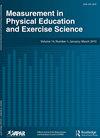加速还是减速?2011-2019年优秀游泳比赛成绩分析预测未来奥运会成绩
IF 1.9
4区 教育学
Q2 EDUCATION & EDUCATIONAL RESEARCH
Measurement in Physical Education and Exercise Science
Pub Date : 2021-07-13
DOI:10.1080/1091367X.2021.1952592
引用次数: 1
摘要
摘要本研究的目的是研究奥运会和世界长距离锦标赛(WLC)在第1 -3名、第4 -8名和第9 -16名三个项目上的发展趋势,并对2024年奥运会进行预测。在2011年至2019年的所有OLY和WLC比赛中排名前16位。线性回归和预测模型被用来检验趋势和预测。总共包含了3061个个人比赛成绩。对于男女,14个奥运会项目中的13个项目发生了显著变化,其中大多数变化表明这些项目有所改善(男性平均:- 0.72%(±0.81%);−0.60%(±0.81%)。对于2024年的预测,事件分为五类:改善;下降;收敛;不同;和稳定。这些结果提供了对成为半决赛、决赛和奖牌得主所需时间的趋势的见解。这一点,再加上2024年的预测,可能允许高性能程序针对特定的OLY事件。本文章由计算机程序翻译,如有差异,请以英文原文为准。
Speeding up or Slowing Down? Analysis of Race Results in Elite-level Swimming from 2011-2019 to Predict Future Olympic Games Performances
ABSTRACT The aim of this study was to examine the trends in Olympic Games (OLY) and World Long Course Championships (WLC) across three performance categories (1st-3rd, 4th-8th and 9th-16th), and to make predictions for the 2024 OLY. Top 16 rankings were obtained for all OLY and WLC competitions between 2011 and 2019. Linear regression and forecasting models were used to examine trends and predictions. A total of 3,061 individual race results were included. For both genders, significant changes were observed in 13 of 14 Olympic events, with most changes highlighting those events have improved (mean: −0.72% (± 0.81%) for Men; −0.60% (± 0.81%) for Women). For the 2024 predictions, events fall into five groups: improving; declining; converging; diverging; and stable. These results offer insights about trends in times required to be a semi-finalist, finalist, and medalist. This, coupled with the 2024 predictions, may allow high-performance programs to target specific OLY events.
求助全文
通过发布文献求助,成功后即可免费获取论文全文。
去求助
来源期刊

Measurement in Physical Education and Exercise Science
Medicine-Orthopedics and Sports Medicine
CiteScore
4.20
自引率
33.30%
发文量
24
期刊介绍:
The scope of Measurement in Physical Education and Exercise Science (MPEES) covers original measurement research, special issues, and tutorials within six substantive disciplines of physical education and exercise science. Six of the seven sections of MPEES define the substantive disciplines within the purview of the original research to be published in the journal: Exercise Science, Physical Activity, Physical Education Pedagogy, Psychology, Research Methodology and Statistics, and Sport Management and Administration. The seventh section of MPEES, Tutorial and Teacher’s Toolbox, serves to provide an outlet for review and/or didactic manuscripts to be published in the journal. Special issues provide an avenue for a coherent set of manuscripts (e.g., four to five) to collectively focus in-depth on an important and timely measurement-related issue within the scope of MPEES. The primary aim of MPEES is to publish high-impact manuscripts, most of which will focus on original research, that fit within the scope of the journal.
 求助内容:
求助内容: 应助结果提醒方式:
应助结果提醒方式:


